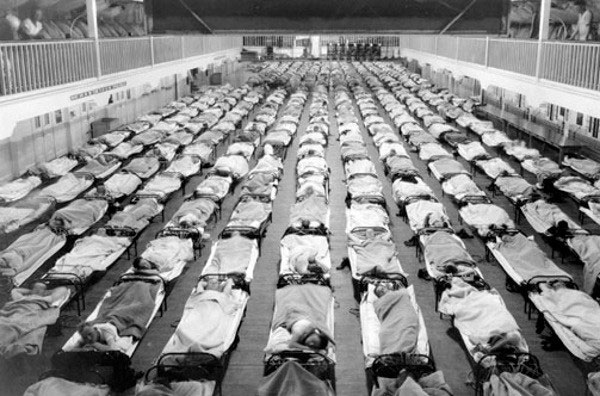In the plethora of deadly epidemics, what is the most dangerous virus in history?
The most deadly virus turned out to be more familiar than we thought.
In fact, viruses are not always dangerous. They exist in every environment on Earth, contributing many important roles to nature.
However, basically a lot of viruses can be dangerous for us, even deadly. But which virus is the most dangerous?
The question is not easy to answer
Obviously, flu viruses are always extremely dangerous . In 1918, nearly 100 million people died of a flu epidemic - a figure equivalent to 5% of the world population at that time. More than 500 million people are infected with the flu, regardless of whether they are young or old, they don't leave anyone alone.
Until now, the flu epidemic in 1918 is still the most deadly epidemic. That is also the reason why scientists today have to work hard, invest a lot of money to prevent any similar flu outbreak from appearing.

The 1918 flu pandemic caused hundreds of millions of deaths.
And for those who don't know, the virus that caused the 1918 flu pandemic was H1N1 . It means that considering the number of deaths, H1N1 is the most dangerous virus.
However, considering the danger does not stop at the number of deaths. Simply because H1N1 can spread quickly and extensively, it can cause disaster. If you consider the death rate in the number of people infected (CFR), many other viruses are much more terrible. Such as rabies .
According to figures released by WHO, rabies viruses appear in 150 countries, present almost every continent (except Antarctica), and 99% become infected by dog bites. This disease has a long incubation period, which makes people afraid of water, fear of light, gradually numb, coma and death.

Rabbits are one of the most lethal diseases.
And according to Elke Muhlberger - Boston University professor of biology, the death rate when infected with rabies is 100% if left untreated.
Fortunately, rabies can be prevented by vaccination. According to statistics, each year 15 million people worldwide are vaccinated, so that hundreds of thousands of lives are saved every year.
Then Ebola . The virus first appeared in 1976 in Sudan, an extremely contagious virus. The lethal rate has been up to 90% in the past, but now "only" 50%. Still, it is much higher than H1N1, and most importantly, there is no effective vaccine to prevent it.
Another virus that also has a high death rate is Marburg . In 2004, an outbreak in Anglolan caused at least 88% of deaths.
HIV is also a virus that needs to be listed as a dangerous group, although this is somewhat complicated. In fact, today HIV is no longer synonymous with a death sentence. If living in moderation, being healthy, infected people can extend life to a decade. Even in the near future, world science will test the HIV vaccine on humans, opening the future to permanently erase this virus.
However, the lethal rate itself does not make a virus more dangerous than other types. This is just one factor. In addition, it is necessary to take into account the extent of the spread, the ability to work in the host, the means of propagation, the ability to survive on many species, the ability of the host to produce antibodies .
"Most of the viruses we avoid are due to vaccines. Like smallpox - one of the most terrible viruses has been wiped out by it," shared Nonia Pariente, a biologist.

In the future are new challenges, related to viruses spread by mosquitoes.
Currently, what is the most dangerous virus?
According to Pariente, the danger of viruses no longer lies in the number of deaths, death rates, or common factors at present. In the future are new challenges, related to viruses spread by mosquitoes.
Priente said, these viruses are difficult to control, and they constantly reappear regardless of any way. Moreover, they tend to increase, because global temperatures are warming. Dengue, yellow fever, zika . all can spread.
At the same time, a concern is equally serious, which is the ability of the virus to change, making some types more and more dangerous. People only have a way to continue to research and prepare, and prevent the worst cases from happening.
- The most deadly plague in history
- Bats - agents that spread many deadly epidemics
- What kind of bacteria can kill hundreds of millions of people coming out from the North Pole?
- Check out the most dangerous viruses on the planet
- Deadly dangers inside the floodwaters after super typhoon Florence
- Find out the evolutionary mechanism of many deadly dangerous bacteria
- More and more viruses are dying around the world, and the reason is not pleasant at all
- WHO caucus about the most dangerous virus created by humans
- Successfully created deadly flu virus in the laboratory
- Detecting deadly virus in the bat
- Startled, the monster used the corpse as a weapon of destruction
- 5 types of epidemics across the century
 Green tea cleans teeth better than mouthwash?
Green tea cleans teeth better than mouthwash? Death kiss: This is why you should not let anyone kiss your baby's lips
Death kiss: This is why you should not let anyone kiss your baby's lips What is salmonellosis?
What is salmonellosis? Caution should be exercised when using aloe vera through eating and drinking
Caution should be exercised when using aloe vera through eating and drinking